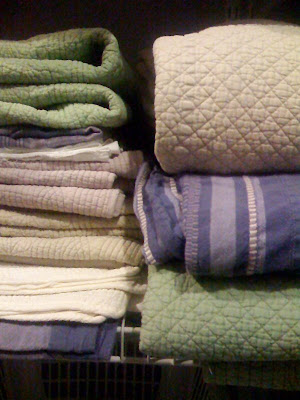
Pizza is my husband's favorite food,
sans doute. However I find most restaurant pizza tedious at best, and finally last year I determined to learn how to make my own. After all I make bread, surely it cannot be harder than that. And so one day as we were in Bed, Bath, and Beyond I saw a pizza stone. I called my husband over and showed him and he agreed that it would be a fun addition to our kitchen. Then we looked at the price. An entire pizza kit with a stone, carrier and peel was on $14.99. Needless to say we snapped it right up and thus began the odyssey to create perfect pizza.
The following is my favorite crust recipe along with sever of my favorite pizza recipes. The crust recipe was modified from the one on the Whole Foods website, whereas the others are all made up by me.
Pizza Dough Recipe
Ingredients1 teaspoon Honey
3 teaspoons active dry yeast
3 1/4 cups bread flour (or vital gluten flour)
Pinch of sea salt
3 tablespoons olive oil, plus extra for coating
Cornmeal as needed
DirectionsFor the dough, put 3 tablespoons lukewarm (around 100°F) water, honey and yeast in a small bowl, mix well and set aside for 10 minutes. (I use a microwave to warm up the water for 10 seconds and this ends up almost the perfect temperature.)
Meanwhile sift flour and salt together in a large bowl. Place 2 1/4 cups of the flour mixture into a mixing bowl and set remaining flour mixture aside. Mix 1 cup lukewarm water with 3 tablespoons of the oil and set aside. Pour yeast mixture into bowl with 2 1/4 cups of the flour mixture and add 2/3 of the water-oil mixture. Mix well with your hands, adding more of the remaining water-oil and flour mixtures as needed to achieve a soft doughy consistency. Knead for about 10 minutes, adding more of the flour mixture if needed, just until it is no longer sticking to your fingers.
Place in a bowl coated with oil and lightly rub oil over the top of the dough. Cover bowl with a moist towel and set aside in a warm spot to let rise for about 1 1/2 hours. (I set it just beside the oven and tuen the oven on to 200° for about 15 minutes.) Once risen, give one punch to the dough ball, remove from bowl and divide into 3 pieces. Gently roll your dough into a ball, then stretch the top of the ball down and around the rest of the ball, until the outer layer wraps around the other side. Pinch the two ends together to make a smooth ball with a tight outer "skin." Set your ball seam-side down where it can rest. Dust your pizza balls with flour, and store them under a damp towel, in a proofing tray, or under plastic wrap. This will prevent the outside of the ball from drying out and creating a crust, and becoming difficult to work with. The top of the pizza ball should be soft and silky. Allow to rise again for about an hour.
Sprinkle some cornmeal as needed to the working surface to avoid sticking. Pull the dough ball gently out into a disc with your hands. At this point you can pretend you are italian and through the dough up in the air spinning and catching it (if you are coordinated). I usually use a rolling pin to flatten each dough ball as much as possible and to roll each out into a 12-inch circle, sprinkling from time to time with cornmeal. Set aside.
Preheat oven to 400°F, with a pizza stone placed in the middle rack. Wait until the pizza stone is thoroughly heated, about 15 minutes. Sprinkle a wooden pizza board lightly with cornmeal and place one 12-inch circle of dough on top. . Place crust on peel and brush top of crust with olive oil. Sprinkle the pizza stone with cornmeal transfer to the hot stone and cook for three minutes. Turn crust and cook for around 3 more minutes or until crust just begins to brown. (I cook my crusts separately before I cover them with ingredients because it helps prevent soggy crust in the middle of the pizza). At this point you can remove the crust add ingredients and cook for 10-15 minutes until browned and bubbling, or cool the crusts and refrigerate or freeze for use later.
Pizza Margherita with Proscuitto
Ingredients:1/4-1/2 cup fresh mozzarella
1/4-1/2 cup goat mozzarella
1/4-1/2 cup 3 cheese blend (parmesan, romano, and asiago for example)
1 small roma tomato (sliced thinly)
2-3 slices of prosciutto (sliced thin)
1 sprig fresh basil (washed and dried)
1/4 cup spaghetti sauce (I use Mom's organic sauce available at Whole Foods and HEB http://www.foodlocker.com/brands-m-mom-s-spaghetti-sauce-co-.html)
Basil pesto
Directions:Brush the crust with with olive oil and then with pesto. Cover the crust with a thin layer of Pasta Sauce. Crumble the fresh mozzarella and goat mozzarella over the crust and then fill in the spaces with the three cheese blend. Place the sliced tomato around the crust. Tear the prosciutto into small pieces and place around the crust. Tear the basil into small pieces and sprinkle around the crust. Cook at 400° for 10-15 minutes until the top begins to brown and the cheese is bubbling.
Vegetarian Pizza
Ingredients:1/4-1/2 cup fresh goat cheese
1/4-1/2 cup goat mozzarella
1/4-1/2 cup 3 cheese blend (parmesan, romano, and asiago for example)
1/4 cup chopped zucchini, squash, onions, mushrooms or other vegetables.
italian sweet pickled peppers
1/4 cup spaghetti sauce (I use Mom's organic sauce available at Whole Foods and HEB http://www.foodlocker.com/brands-m-mom-s-spaghetti-sauce-co-.html)
Basil pesto
Directions:Brush the crust with with olive oil and then with pesto. Cover the crust with a thin layer of Pasta Sauce. Crumble the fresh goat cheese and goat mozzarella over the crust and then fill in the spaces with the three cheese blend. Place the vegetables around the crust. Tear the sweet peppers into small pieces and place around the crust. Cook at 400° for 10-15 minutes until the top begins to brown and the cheese is bubbling. (The sweet pepper are the secret ingredient to the pizza, without them it is pretty bland.)


 Ok, I have to say I am a total
Ok, I have to say I am a total 





































